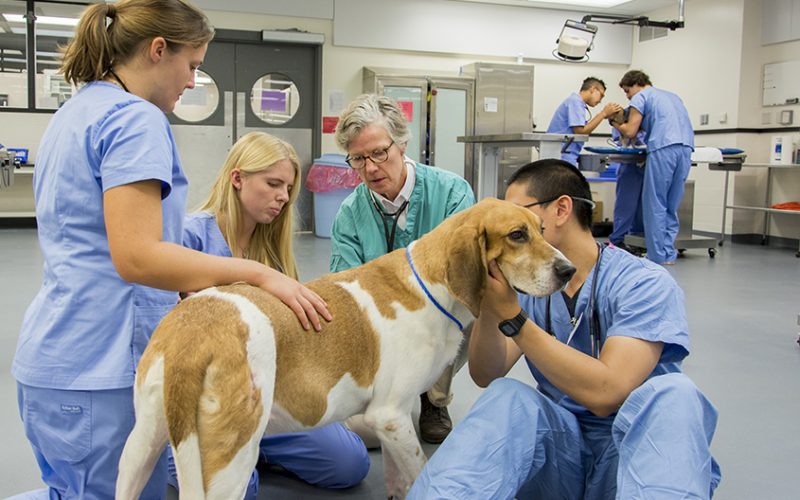For persons that want to become veterinarians, having the proper training is highly needed. We’ll be seeing how long is vet school in Texas, California, USA, and the requirement.
How Long Is Vet School In The USA
Getting a bachelor’s degree increases your chances of acceptance to vet school. However, some students have been approved despite only having completed the prerequisites for vet school.
For instance, before applying to the DVM program at Cornell, candidates must complete a total of sixty-semester credits. Which can be completed without earning a bachelor’s degree by simply taking the prerequisite courses. But even so, the majority of applicants accepted into vet school have a bachelor’s degree, so if you have the ability to obtain one, it will greatly improve your chances.
If you make a decision to pursue a bachelor’s degree before applying to vet school, bear in mind that you are not required to major in a field related to veterinary medicine. Because the admissions committee is heavily focused on your grades, you should choose a degree that interests you rather than one that you believe will get you into vet school.
A bachelor’s degree typically takes four years to complete, but this varies depending on the student. You set the tone for your accomplishments.
How long Is Vet School In The USA
Vet school necessitates an additional four years of study. Veterinary school, like medical school, becomes increasingly harder as you progress through the years. Unlike medical school, veterinarian school teaches students about various animal species so that they may decide which discipline of veterinary care they want to concentrate in.
Here is a thorough description of your four years of vet school to help you understand what is required of you.
The First Year: How long Is Vet School In The USA
The first year of veterinary school is dedicated to learning the fundamentals. However, the majority of your time will be spent in labs or lectures covering the fundamentals of disciplines like anatomy and physiology.
Moreover, you’ll be spending a lot of time learning general knowledge that you’ll need throughout your career, so build solid study habits as well. But don’t just memorize the knowledge to pass an exam. Make an effort to keep up with your work as well.
If you have any free time between classes and studying, you should think about joining any groups. In addition, c Cornell University has a wide range of veterinary school clubs and organizations. Moreover, these clubs allow students to explore potential specialties and gain further exposure to the field of veterinary care.
The Second Year: How long Is Vet School In The USA
The second year of veterinary school builds on your previous knowledge of veterinary medicine while delving deeper into pathology. Moreover, you’ll learn about diseases and remedies, as well as how these ailments manifest themselves in your furry patients.
In your second year, your labs will continue, but you will gain additional hands-on experience. Hence this is where joining clubs can help. The clubs provide you with outside experience that is different from what you do in class, and it is a terrific method to practice.
The third-year: How long Is Vet School In The USA
The third year of veterinary school presents you with technical skills including diagnosis and treatment, as well as the opportunity to improve surgical abilities. You can also take electives during the same time to explore your interests and decide if you want to pursue a specialty in your veterinary career.
The fourth-year: How long Is Vet School In The USA
The fourth and final year of veterinary school immerses you completely in the life of a veterinarian. Moreover, you work in clinical rotations, where you meet patients and learn about the diagnosis and treatment process. These are the final phases in your transformation from student to doctor.
When you are not working in a clinical, you must spend a significant amount of time studying for the North American Veterinary Licensing Examination (NAVLE). Meanwhile, to practice veterinary medicine, you must pass this exam. You cannot advance in your veterinary medicine profession unless you pass this exam, just as you cannot in medical school.
How Long Is Vet School In Texas
A STEP-BY-STEP GUIDE TO BECOMING A VETERINARIAN IN TEXAS
Many people aspire to be veterinarians so that they may aid animals. This is a worthy objective, but it will not be achieved quickly.
What are the requirements for becoming a vet in Texas?
There was a lot of schooling. It takes between 7 and 9 years to finish the necessary undergrad prerequisites as well as a vet school in order to finally get your veterinary license and don the white coat.
Whether you’re just starting high school or getting ready to start applying to colleges, here are a few things to keep in mind if you want to become a vet.
Science And Math Learning: How Long Is Vet School In Texas
As with any path involving the sciences, you’ll need a solid foundation, and high school is an excellent place to begin laying it. Furthermore, take as many advanced math and science classes as you possibly can. If you qualify, take advantage of the AP classes, which may lower the number of classes you’ll need in college and, albeit marginally, lessen the time it will take to complete your program.
Get Your Undergraduate Degree: How Long Is Vet School In Texas
Every decision you make during your undergrad program should be made with the intention of applying to vet school in mind. Moreover, the prerequisite for each veterinary school change slightly, so familiarize yourself with the requirements of the schools you’re interested in.
In general, this will comprise biology, chemistry, physics, and math studies. Depending on the school, you may also be required to take biochemistry, mammalogy, and other advanced classes.
In addition, you should think of your four years in college as a strategy to develop a strong application to veterinary school. Moreover, many colleges and universities include pre-professional organizations that assist students in achieving their declared career goals. Participating in a pre-veterinary club is a great option, as is volunteering for internship experience in a similar field.
Vet School in Texas
Acceptance into your preferred vet school is a major accomplishment. And if you’ve made it this far, you should be quite pleased with what you’ve accomplished. Meanwhile, It’s now time to go to work and master the abilities you’ll need to become a qualified veterinarian.
Utilize any accessible research projects and other programs to the fullest extent possible. These programs are how many veterinary students decide on a specialty or select research over the practice.
Obtain Your License: How Long Is Vet School In Texas
Every state, including Texas, requires veterinarian school graduates to pass the North American Veterinary Licensing Exam. Moreover, you must also pass the State Board Examination in Texas.
The truth is that many people find the answer to how to become a vet to be overwhelming, and it is not for everyone. Those who want to deal with animals in a medical setting can pursue a career as a vet tech.
How Long Is Vet School In California?
California best vet medicine school are extremely competitive institutions. In actuality, applicants should anticipate having a bachelor’s degree in a similar field such as very competitive within the state of Alabama. Hence needing a high-grade point average and a bachelor’s degree in a related discipline such as physiology molecular biology along with a very high GPA to be eligible for admissions. Moreover, the rigorous science-based curriculum of California vet medicine school programs normally takes four years to complete. Students who complete the California vet school program will be awarded a DVM or VMD (Doctor of Veterinary Medicine) degree. Furthermore, the California Vet school Medical Board will require graduates intending to practice in the state to pass the North American Veterinary License Exam (NAVLE) and complete all other board-mandated standards.
Vet School Requirement
#1. Acquire animal experience: Vet School Requirement
If you enjoy being around animals, now is the time to embrace that trait. Getting hands-on experience with animals, as well as activities that involve animals without a veterinarian present, will help you become comfortable working with a wide range of species. According to Dr. Ochoa, you could volunteer at a horse stable, shelter, or animal boarding facility.
Since veterinary schools do not usually specify the number of hours they expect. Moreover, they do take your involvement in animal experience into account when evaluating your application. According to data from the Association of American Veterinary Medical Colleges (AAVMC), applicants have an average of 1,100 hours of animal experience. However, it is more vital that you concentrate on consistent participation in high-quality activities. And you can start gaining animal experience long before you start college.
#2. Complete all needed coursework: Vet School Requirement
Prerequisite course requirements for veterinary schools are quite stringent. Most schools expect applicants to have completed biology or zoology, biochemistry, English, inorganic chemistry, and organic chemistry classes, but there is considerable variation after that. Moreover, you can learn more about specifics by comparing schools using the AAVMC’s Veterinary Medical School Admission Requirements (VMSAR) tool. Because school requirements differ so greatly,
#3. Get Veterinary experience to demonstrate what the field is like.
“Veterinary experience is gained by working alongside a veterinarian, such as shadowing in a clinic or hospital,” Dr. Ochoa clarifies.
#4. Take on the Gre: Vet School Requirement
Most veterinary schools still need the Graduate Record Examination (GRE) as part of the application process. Because veterinary education is demanding, institutions strive to ensure that they only admit students who are up to the task. In addition, you might find it useful to look through the average GRE percentile scores for approved students.
#5. Get excellent evaluation letters: Vet School Requirement
Letters of evaluation, also known as letters of recommendation, are an important component of a solid application package. Furthermore, they present outside perspectives that can assist admissions committees in gaining a better understanding of who you are.
#6. Write a thoughtful essay: Vet School Requirement
While it’s natural to believe that your GPA and GRE scores are the most essential factors that colleges consider, don’t overlook the relevance of your essay. VMCAS requires a personal statement of 3,000 characters or fewer. Moreover, Take time to think about your response to the essay recommendations on the page. After all, you want to be thoughtful as well as accurate.
#7. Ensure to comply with all school requirements.
It’s a good idea to familiarize yourself with VMSAR before beginning your online application. Furthermore, expectations differ from school to school, so don’t be caught off guard. Moreover, there is even an area on the VMCAS application where you can upload supplementary coursework and essays as desired by certain programs.
#8. Send complete VMCAS application
While you’ll undoubtedly be working on your veterinary school application requirements for quite some time. You’ll need to sit down and pull everything together when submitting your VMCAS application. Furthermore, filling up basic personal information, recording every coursework you’ve finished, stating student organizations. Or clubs you’ve been engaged with, highlighting achievements, and more are all part of this process. Finally, official transcripts, GRE scores, and letters of recommendation must also be supplied electronically.
What Is the Future of Veterans’ Employment and Pay?
The average yearly wage for veterinarians in the United States is $121,565. The geographical area, type of practice, level of education, and level of experience all affect an individual veterinarian’s pay. For instance, a veterinarian in their first year at a small-town practice often makes less money than a veterinarian with 10 years of experience working for a private laboratory who is board certified.
By 2031, employment in veterinary medicine is predicted to expand by 19%, substantially faster than the average for all occupations, according to the United States Bureau of Labor Statistics (BLS). Over the next ten years, the BLS predicts that there will be roughly 4,800 openings for veterinarians. The BLS attributes this increase in employment to the growing and aging pet population as well as scientific advancements in domestic animal healthcare.
Conclusion
How long is vet school talks of the duration of years it takes to become a veterinarian and other requirements
How long is vet school FAQ’s
How many years does it take to be a veterinarian?
Aspiring vets can expect to devote about eight years to their higher education if they spend four years in college and four years in vet school earning a doctor of veterinary medicine, or D.V.M., degree
How difficult is vet school?
Very difficult – many say it’s harder than medical school. You must have a high GPA, high GRE scores, veterinary work experience, and references. It’s a real-time commitment at least 7 years post-high school.
What GPA do you need to get into vet school?
Most vet schools will look very carefully at your choice of courses in the last three or four semesters and will generally be looking for a GPA of 3.5 or higher.






